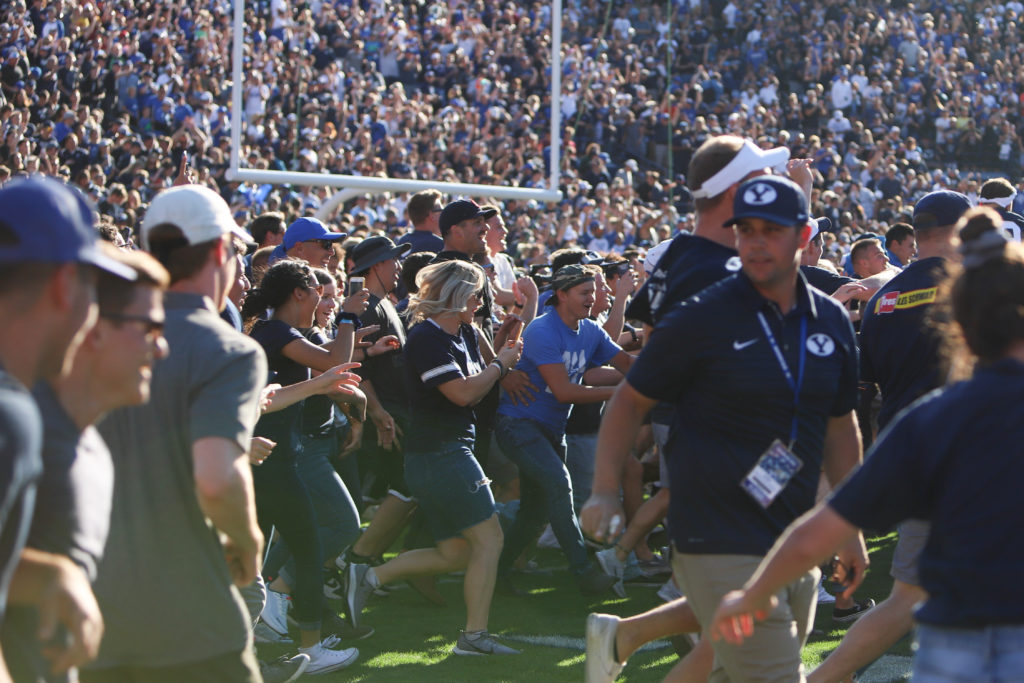
Editor’s note: This story is a part of a series that explores the lasting impacts of the COVID-19 pandemic and how things have changed on and off campus.
The excitement that comes from watching a performing group take the stage in front of a sold-out crowd, or the adrenaline rush from cheering alongside thousands of sports fans during the first game of the season are atmospheres that may never be the same after the COVID-19 pandemic.
While specific changes as part of the “next normal” of large entertainment gatherings on the BYU campus remain undetermined by school officials, the concerns are clear.
“The biggest concern is population density,” BYU health science professor Chantel Sloan said. “The closer people are together, the more likely things are to spread. Large gatherings at sports and entertainment venues can be difficult to control.”
Sloan pointed out that even if BYU concert, theater and sporting venues were to only allow a fraction of the normal crowd in and space people six feet apart, high-density clusters of people could still take place. Minimizing the number of people at bottleneck entryways, hallways, restrooms and concession stands could be a tall task.

The potential spread of the virus through high-touch areas like door handles and restroom fixtures at venues is another cause for concern.
These forms of virus transmission mean outdoor venues likely have just as high of a contaminant potential as indoor venues, despite the fresh air.
“It’s not really about the virus spreading up, getting into the ventilation system, and then getting blown out to the entire stadium because this virus doesn’t seem to transmit that way,” Ryan Demmer, an epidemiologist at the University of Minnesota’s School of Public Health, told The Associated Press. “It doesn’t aerosolize that well.”
Possible changes
Sloan expects a number of changes in the audience experience to be implemented, such as encouraged or mandated mask wearing and frequent sanitizing of common areas.
Sloan anticipates people more susceptible to contracting the virus will be encouraged not to attend such events. She also hopes people who have experienced any sort of symptoms would be honest with themselves and choose to stay home, rather than put others at risk.
Screening stations at venue entrances with temperature checks could become a common sight. Supplies permitting, COVID-19 testing could also become part of the new norm and pre-entry screening process.
Although such precautions could limit the potential spread of the virus and allow audiences to congregate sooner than some might think, keeping such events completely free of the virus may be impossible.
“As long as COVID-19 is still actively circulating, you can’t virus-proof events 100%,” Sloan said.

Long-term implications
In addition to some of the short-term changes to the audience experience at BYU entertainment gatherings, the pandemic could have some longer-term implications. Sloan hopes that even after the virus is eradicated, people will be more hesitant to go around others when feeling ill.
“I hope that’s a change our society makes at large, with employees, students and citizens having protective policies in place that allow them to have imperfect immune systems and stay home sometimes,” Sloan said. “As a society, I think we have allowed and even cheered for people ‘pushing through’ being infected with something and not taking the time to heal and protect others.”
While long-term consequences of the current pandemic remain to be seen, BYU audience members and fans can expect to see significant changes the next time they attend a concert or sporting event as part of the “next normal.” Whether that be in a few weeks or a few months, the changes will reflect one single motive: caution.
“A lot of infection happens because people are about to start showing symptoms in the next day or so, but haven’t yet,” Sloan said. “Be extra careful. You never know who else is in the audience that could have a severe outcome from that infection.”





